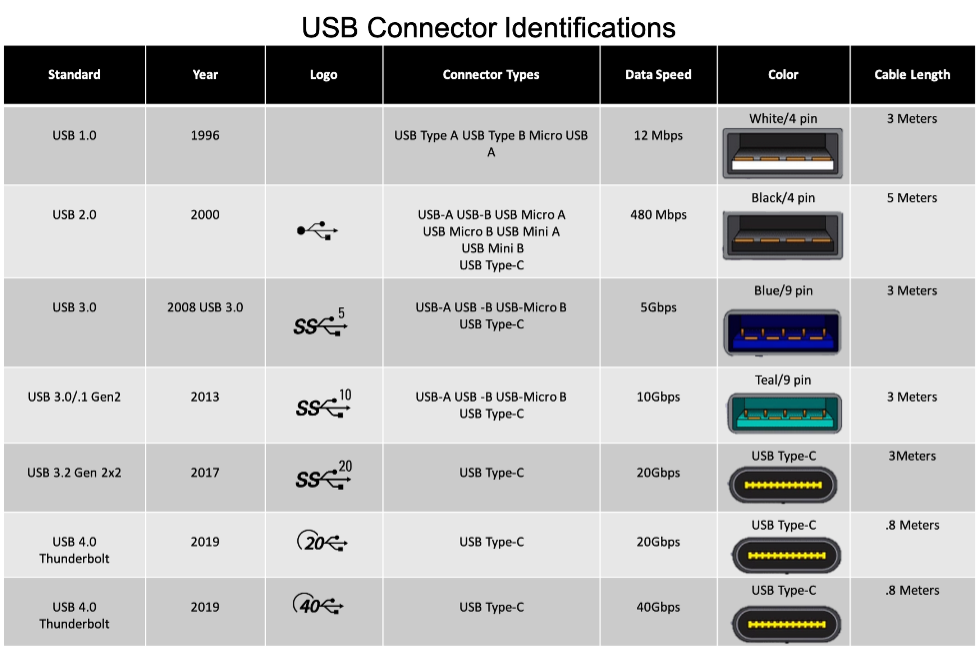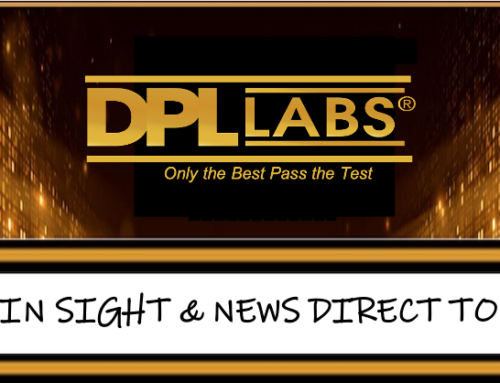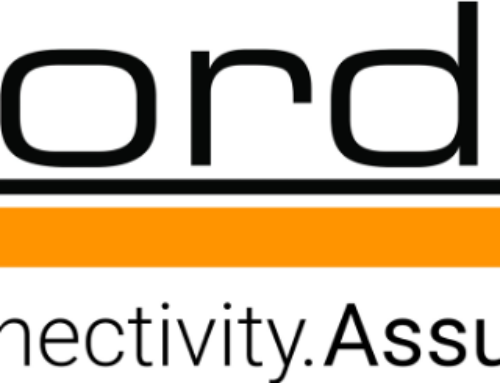DPL LABS & USB
Part 2 of 2
Thunderbolt: Developed by Intel, Thunderbolt was initially marketed under its project name Light Peak. It is a high-speed optical interface that allows for the connection of peripherals, such as external hard drives, monitors, and other devices, to a computer. It was developed by Intel in collaboration with Apple and was first introduced in 2011. Later changed to a copper transmission line, Thunderbolt combines two serial signals, Display Port and PCI Express while using Display Port’s mini connector. It supported high-speed data transfer, video output, and power delivery into a single, compact port. It uses a serial data interface that can transfer data at high speeds, making it suitable for demanding tasks such as video editing and transferring large files. Thunderbolt supports daisy-chaining, which means multiple devices can be connected in a series through a single Thunderbolt port.
- Thunderbolt 1: Born out of a project named “Light Peak”, this technology started its life with an optical interface bringing incredible speeds, making the transfer and display of high-resolution data.
- Thunderbolt 2: Code name “Falcon Ridge” The revision claimed a 20Gbps data rate allowing for two 10Gbps lanes making it a bit more flexible. It supported 4K video, brought bidirectional transfer, and multiplied channel aggregation
- Thunderbolt 3: Thunderbolt 3 code-named “Titan Ridge”, was the first Thunderbolt to use the USB Type C connector which is more versatile than USB in terms of data transfer capabilities and can support additional features, including power delivery. Here are some key points of Thunderbolt 3:
- Supports USB-C connectors and USB-C Power Delivery.
- Halves Power Consumption.
- Can deliver data, video, and power over a single cable, making it more suitable for docking stations and external displays.
- Provides faster data transfer speeds (up to 40Gbps) compared to USB-C’s 20Gbps limit and can reach 40Gbps if tunneling is supported.
- Can simultaneously drive two external 4K displays at 60Hz or one at 120Hz or 5K@60Hz using Apple’s Mac Book.
- Thunderbolt 4: Code named “Tiger Lake” Thunderbolt 4 supports all previous features of Thunderbolt 3 with additional features:
- Supports Alternate Mode for Multi-port accessory Architecture beyond Daisy Chaining.
- Maintains the 100W power delivery capability and improves data transfer speeds.
- Displayport™ 2.0 can support higher than 8K resolution 60 Hz by way of UHBR (Ultra High Bit Rate) signal standards.
- Thunderbolt 5: Code-named “Barlow Ridge” worked along with USB-IF and the USB 4.0 specifications offering:
- Increased bandwidth to 80Gbps, double that of Thunderbolt 4
- One direction bandwidth of 120Gbps capable of supporting 2 8K displays
- Supports Display Port 2.1
- Increases power from 100W to 240W
Both USB-C and Thunderbolt 3/4 support Power Delivery and their main differences are that Thunderbolt offers additional data transfer capabilities, making it suitable for more high-performance applications like external GPUs, 4K, 5K, 8K, 10K displays, and high-speed data storage, while USB is more commonly used for everyday charging and basic data transfer needs. The choice between USB and Thunderbolt 3/4 for power delivery depends on the specific uses and capabilities of connected devices.
Displayport™: USB Type-C Compatibility: Many modern laptops and devices come with USB-C ports that support Displayport™ over USB-C. This makes it convenient to connect a wide range of devices with a single cable.
Displayport™ has become a popular choice for connecting high-quality displays, especially in the PC and professional display markets. It offers a range of features and capabilities that cater to the demands of modern computing and multimedia applications.
It’s important to note that the specific state of serial connectivity may vary by industry and region. Industries with heavy investments in older equipment may continue to rely on older serial connections, while newer technologies are more prevalent in consumer and office settings. The adoption of new communication standards and the phase-out of older ones will continue as long as there is an economic reason to keep them.
The Sudden Shift
The sudden shift in serial connectivity is primarily driven by the emergence of USB 4.0 and Thunderbolt 5 technologies. These standards promise to unify data and power delivery across a wide range of devices, including laptops, smartphones, displays, and peripherals. USB 4.0, for instance, supports data transfer speeds of up to 40 Gbps, surpassing previous USB iterations, and allows for daisy-chaining devices, simplifying complex setups. USB extends USB 4.0 data and protocol limits to data rates of 80Gbps and when configured asymmetrically it can reach 120Gbs in one direction and 40Gbps in opposite directions. Remember that USB 4.0 also supports Display Port 2.1.
The Implications:
- Universal Compatibility: One of the most significant advantages of this shift is the potential for universal compatibility. With USB 4.0 and Thunderbolt 5 becoming more prevalent, users can connect devices seamlessly, irrespective of the brand or type. This can lead to a reduction in the number of cables and adapters required, making it easier for consumers to connect and use their devices.
- Faster Data Transfer: The increased data transfer speeds offered by USB 4.0 and Thunderbolt 5 are a game-changer. This allows for smoother, faster data transfer between devices, which is crucial for applications such as 4K video editing, gaming, and large file transfers.
- Reduced E-Waste (Going Green): Standardization can lead to a significant reduction in electronic waste. As fewer cables, connectors, and adapters are needed, there will be less waste generated from obsolete or incompatible accessories.
- Enhanced Productivity: A standardized serial connectivity landscape can boost productivity by simplifying device connectivity and reducing the time spent troubleshooting interoperability issues. This is particularly important in professional settings where efficient workflows are paramount.
- Potential Challenges: While the shift towards standardization is promising, it may face challenges in the form of legacy devices and resistance from manufacturers reluctant to abandon proprietary technologies. Transitioning to the new standards may require adaptors or dongles for older devices.
Apple’s most recent decision to completely convert their iPhone Lightning port to a USB-C connector and cable now changes the entire landscape of connectivity. Thus far, unfortunately, the transition has not been as smooth as many would have thought. It all boils down to compatibility and its adaptation to this kind of cable. It has been reported that Apple’s incredible success with inoperability and reliability with Lightning was due to their strict control over cable integrity and compliance by way of MFi (Made for iPhone, iPad, or iOS) program. A large amount of cable pundits believe that USB-C cable compliance and tests do not have the same level of scrutiny as Apple’s Lightning MFi program. This one factor can be a significant challenge to move this ball forward. Reducing the number of different types of connecting devices to just one will drive the cable industry to levels never experienced before. You have to consider how many cables make up Mobil phones, external devices, video interface products, audio DACs, and the list goes on. USB-Type C cables can become the common denominator for connectivity allowing manufacturers to focus their attention on just one type of cable rather than many. Their skill sets will increase with better reliability and performance.
In summary, both USB-C and Thunderbolt 3/4/5 support Power Delivery, with the main difference being that Thunderbolt offers additional data transfer capabilities, making it suitable for more high-performance applications like external GPUs, up to 10K displays, and high-speed data storage, while USB-C is more commonly used for everyday charging and basic data transfer needs. The choice between USB-C and Thunderbolt 3/4/5 for power delivery depends on the specific use case and the capabilities of your devices and cables.

“In an era of booming technology, ensuring dependable digital connectivity has never been more crucial. At DPL Labs, we’re paving the way by beginning a comprehensive USB-C test and verification services.”
Every day, we rely on an array of digital devices that increasingly adopt USB-C connectivity. From laptops and smartphones to headphones, chargers, and displays USB-C provides a universal means of charging and data transfer. But how can we ensure that every USB-C product on the market delivers a consistent, high-quality experience? Having a common interface will no doubt put more weight on each cable’s integrity including performance, E-Marker verification, high-speed tunneling, and most importantly power delivery. That’s where DPL Laboratories (DPL Labs) comes into the picture. As a leading provider of testing and product certification USB-C testing and verification will be added to DPL Labs service offerings.
Why is this so important?
USB-C is quickly becoming a universal standard, embraced by leading technology companies worldwide. Because of this, any flaws or inconsistencies in the design and functionality of these cables can lead to significant problems including Signal Integrity for all claimed data rates, and verifying Power Delivery, not only for the cable’s physical capabilities but also the embedded instructions (E-Marker) allowing all devices to communicate properly for all forms of USB standards. Hence, the testing and verification carried out by DPL Labs will carry immense relevance.
The Importance of Testing and Verification
Accurate and rigorous testing plays a crucial role in ensuring the reliability and efficiency of any technical product. Tests are meant to track down potential flaws and inconsistencies that could later cause problems and malfunctions. For USB-C cables, issues might range from both poor data transfer and poor power management. Furthermore, these tests establish a Market credibility for manufacturers, ensuring that their customers know they are keeping up with industry standards for quality and performance.
“Quality is more than a promise, it’s genuine performance.”
Reliable testing and verification are, therefore, not just about improving the product; they’re about building and maintaining trust with consumers. Having a product tested and verified by a reputable laboratory such as DPL Labs provides manufacturers with a seal of approval, showcasing their commitment to quality and performance.
Through its testing and verification services, DPL Labs will be performing crucial tasks in improving the standards of technology in our everyday lives. For consumers, the benefits range from enhanced performance to increased longevity of their devices.
Technology will never stand still, and neither will DPL Labs. As a leading testing and verification company, DPL Labs understands the importance of staying ahead of the curve in an ever-evolving technological landscape. With the rapid advancements in technology, it is crucial for companies like DPL Labs to continuously adapt and innovate to meet the changing needs of the industry. By constantly pushing the boundaries of testing and verification, DPL Labs ensures that they are at the forefront of technological advancements, providing reliable and accurate solutions to their clients.
“DPL Lab’s commitment to USB-C testing and verification holds a promise: A Safer and more reliable technology for everyone.”
“Only the Best Past the Test”



